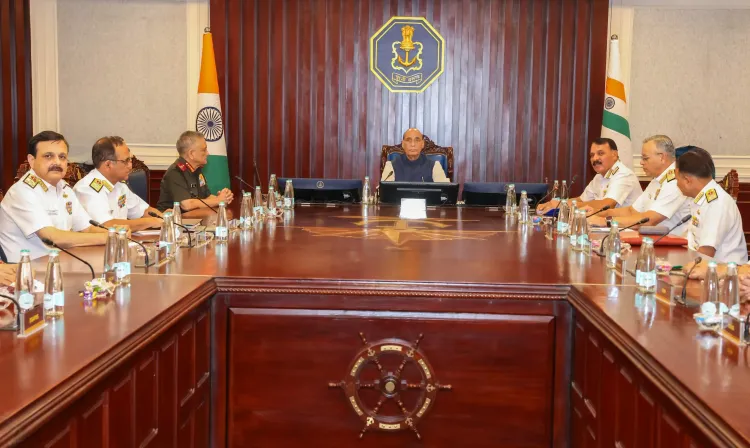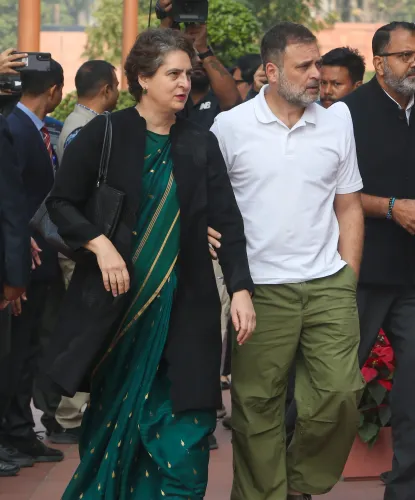Is India Prepared for Challenges? Rajnath Singh Highlights Operation Sindoor as a Testament to Strength

Synopsis
Key Takeaways
- Operation Sindoor showcases India’s military readiness.
- The Indian Navy’s deterrent posture enhances regional security.
- Emphasis on Aatmanirbhar Bharat drives job creation and self-reliance.
- Technological advancements are vital for modern maritime warfare.
- The Navy plays a critical role in the Indian Ocean Region.
New Delhi, Oct 23 (NationPress) Defence Minister Rajnath Singh emphasized on Thursday that ‘Operation Sindoor’ represents India’s determination and capability, sending a clear message to the global community that the nation is always poised to tackle any challenge.
During his remarks at the Naval Commanders’ Conference in New Delhi, the Defence Minister praised the Indian Navy for establishing a deterrent stance that has compelled Pakistan to stay close to its coastline. He asserted that the world has observed the Navy’s operational readiness, professional prowess, and strength during this operation.
He characterized the Indian Navy’s role in the Indian Ocean Region (IOR) as a source of “comfort for allied nations” and “discomfort for those who aim to disrupt regional stability,” stating, “The IOR has emerged as the focal point of modern geopolitics, transforming from a passive area into one of competition and collaboration.”
“Through its diverse capabilities, the Indian Navy has assumed a leadership role in the region. Over the past six months, our vessels, submarines, and naval aircraft have been deployed at an unprecedented scale,” he remarked.
Furthermore, he noted that the Navy has ensured safe passage for around 335 merchant vessels, representing approximately 1.2 million metric tons of cargo valued at $5.6 billion. This underscores India’s evolution into a reliable and capable partner in the global maritime economy,” he added.
Rajnath Singh emphasized that a self-sufficient Navy is essential for a confident and robust nation, stating, “In the last decade, nearly 67% of the Navy’s capital acquisition contracts have been awarded to Indian industries. This clearly indicates that we are not merely reliant on imports; we are leveraging our own talent and the capabilities of MSMEs and startups.”
Highlighting that modern warfare is increasingly technology and intelligence-based, the Defence Minister commented, “Maritime preparedness now transcends ships and submarines; it is driven by technology, network-centric, and autonomous systems. We must shield ourselves from our adversaries’ advanced technologies while simultaneously enhancing our own capabilities.”
Discussing Aatmanirbhar Bharat and the job opportunities it has generated in the maritime sector, he stressed that, “With each ship and submarine built, new jobs are created; with every engine manufactured, new skills are developed, and with each indigenous system, India’s dependency diminishes. The Project 17A vessels, which boast over 75% indigenous content, have generated approximately 127,000 jobs in shipyards like MDL and GRSE. This demonstrates that every Navy project is intertwined with security, the economy, and youth employment.”
Key officials present included CDS Anil Chauhan, Navy Chief Admiral Dinesh K Tripathi, Defence Secretary Rajesh Kumar Singh, DRDO Chairman Samir V. Kamat, and Naval Commanders. The conference serves as a forum for close engagement with national leadership and bureaucrats, refining the Indian Navy’s strategy to address multi-dimensional challenges in the current geo-strategic landscape. The Navy’s senior leadership is assessing its operational readiness along both western and eastern seaboards, promoting indigenization and innovation under the Make-in-India initiative, advancing the government’s vision of MAHASAGAR (Mutual and Holistic Advancement for Security Across all Regions), and positioning the Indian Navy as the Preferred Security Partner in the IOR and Indo-Pacific.









